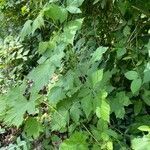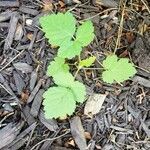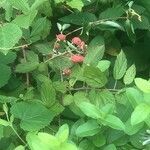Shrubs, 5–25 dm, armed. Stems ?biennial?, erect, ?primocanes and floricanes later over-arching?, glabrous or sparsely puberulent, eglandular, strongly pruinose; prickles sometimes sparse, erect or hooked, narrow to stout, 4–8 mm, narrow-to broad-based. Leaves deciduous, ternate or palmately compound; stipules filiform, 5–10 mm; ?petiole usually armed with prickles; petiolules of terminal leaflets also sometimes armed; lateral leaflets sessile or subsessile?; leaflets 3(–5), terminal ovate to lanceolate, 5–14 × 3–11 cm, base rounded to cordate, unlobed or laterals sometimes lobed, margins finely to doubly serrate, apex acute, abaxial surfaces sometimes with hooked prickles on midveins, densely white-canescent to tomentose, eglandular. Inflorescences (2–)3–7(–20)-flowered, cymiform or umbelliform. Pedicels: prickles erect, hooked, puberulent to pubescent, eglandular. Flowers bisexual; petals ?initially erect, later ascending?, white, narrowly obovate to elliptic, 5–10 mm, ?apex sometimes emarginate?; filaments laminar; ovaries tomentose. Fruits usually dark purplish to black, rarely amber, ?pruinose, aromatic?, depressed-globose, 1–1.5 cm; drupelets 20–50, coherent, separating from torus. 2n = 14.
More
Stems erect or ascending, or sometimes arching and rooting at the tip, not glandular, strongly glaucous at least the first year, sparsely beset with stout, straight or hooked prickles with expanded base, as are also the petioles and especially the pedicels; lfls mostly 3, or 5 on the primocanes, the intermediate pair then adjacent to the lower; uppermost lvs of the floricane often simple; terminal lfl broadly ovate, rounded or subcordate at base, sharply, deeply and irregularly serrate; lower lfls similar but smaller and narrower; all lfls thinly gray-tomentose beneath; fls 3–7 in a dense, umbelliform cyme, often also 1 or 2 from the upper axils; pet white, shorter than the sep, narrowly obovate, at first erect, soon deciduous; fr purple-black (yellowish), with narrow belts of white tomentum between the drupelets, 1 cm thick, separating as a unit from the persistent receptacle; 2n=14. Dry or moist woods, fields, and thickets; Que. to N.D. and e. Colo., s. to Ga. and Ark. May, June. Also cult. in many cultivars. Hybridizes with no. 7 [Rubus idaeus L.].
A shrub. It grows 3 m high and spreads 3 m wide. It loses its leaves during the year. The stems are curved and prickly. The leaves are dark green and have 5 leaflets on non flowering stems and 3 leaflets on flowering stems. The leaves are white and like felt underneath. The flowers are white. The fruit are dark purple. They are edible. Some named varieties occur.
Rich thickets, ravines and borders of woods, often in full shade and preferring moist positions. Woodlands, fields, prairies, meadows, savannahs, in disturbed areas, dry to moist soil; at elevations up to 1,000 metres.
More
It is a temperate plant. It suits hardiness zones 3-9.
The fruit are eaten raw. They are also dried or used in jams, jellies, pies, sherbets, preserved or made into vinegar. They are canned. Young shoots are eaten like rhubarb. The leaves and the bark of the roots are used for tea. Wilted leaves should not be used. They should be fresh or dried.
Can be grown by cuttings or seedlings. Seeds needs stratification.












